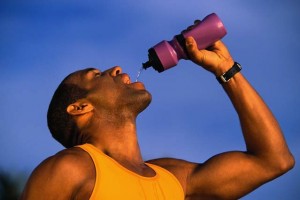Optimal Water Intake
Without a regular supply of it you can get fatigued, headaches and joint problems.

What is it? It’s not aspirin! It’s the latest new wonder drug: pure water.
Surveys show that most of us don’t drink enough water.
Most people are chronically dehydrated – and don’t even know it.
The result is a type of dehydration that can affect important bodily functions. Proper hydration is essential for regulating your temperature, cushioning all the joints of your body, eliminating wastes, and countless other essential functions.
How much water should you drink each day?
Use this simple formula:
- You must drink at least 33 ml of water per kilo of body weight per day.
- For example; a 100kg person needs a minimum of 3.3 litres per day.
- A 75kg person needs a minimum of 2.4 litres per day.
- You will need to increase this to at least 40 ml if it is hot and dry.
- If you work outside or you do sport this can easily increase to 500ml per hour (or more) depending on how much you sweat.
Tip for athletes:
Before you train/run/exercise measure yourself on a set of digital scales. Measure a precise amount of water that you will use when you are training (say 1 litre). Do not eat or drink anything else other than this measured amount. Do not go to the toilet (only for this session).
Complete your training and then measure yourself again. Subtract the second measurement from the first and add the weight of the fluid (1 litre = 1kg) you consumed during training. The final figure will give you the amount of water you MUST take when you are training – otherwise you will become dehydrated.
Make sure you avoid beverages that contain caffeine or alcohol. They tend to act as diuretics, removing water through more frequent urination!
Your body is about 75% water. Drinking enough of it so your body can operate correctly is one of the simplest and easiest things you can do all day long to help stay well.
A Few Good Tips for Drinking the Right Amount of Water
- Work out what is the appropriate amount of water for you need to drink each day. (This is usually between one to two litres per day.)
- Fill a one litre container (i.e. an empty soft drink bottle or your “special” water bottle) and carry that with you for the day. Take the water bottle with you in the car, meetings, watching television or while working at a desk. By taking regular small sips you will be surprised at how much water you can easily consume.
- By spreading the drinking during the day it will become less of a chore and you will be able to keep track of exactly how much you have drunk (rather than trying to remember how many glasses you drank at breakfast!).
- By drinking regularly you will be constantly cleansing your system. Regular water intake will flush your body of toxins and promote improved health and well-being. Regular water intake improves kidney and liver function allowing these organs to work more efficiently which is important when recovering from illness or injury (a back problem), poor diet, stress and pressure of a busy lifestyle.
- When you drink regularly you will be less likely to consume unnecessary coffee and “cola” soft drinks. Usually the body signals to us we are thirsty. We interpret this to mean we “need a coffee, coke or cup of tea”. We have the caffeine hit but it has a negative effect on our water balance (caffeine removes water from our system – it is a diuretic). So our body is still thirsty! Soon after we then feel we need another coffee or coke drink!
- By drinking water regularly you will also be less likely to become hungry and snack on unnecessary foods. Regular water intake promotes a feeling of “fullness” within the stomach. This is the easiest and cheapest way to lose weight and body fat.

Thirsty People Feel More Pain
Going without a drink can make you more sensitive to pain, a study has found. Australian pain expert Dr Michael Farrell of the Howard Florey Institute in Melbourne and team report their findings in today's issue of the Proceedings of the National Academy of Sciences.
"This is another demonstration of the plasticity of pain responses," he said. "In this particular instance a mild perturbation of electrolyte levels, which is fundamentally what gives rise to thirst ... is enough to modify the pain response". Dr Farrell and the team studied the relationship between thirst and pain in 10 people. The study participants had pressure applied to their thumbs to induce mild pain and were given saline injections to stimulate thirst.
Blood Flow ScanThe researchers used a positron emission tomography (PET) scan to measure blood flow in the brains before and after. The results showed that people who were thirsty felt more pain. Two regions of the brain, the pregenual cingulate and ventral orbitofrontal cortex, which were not turned on by either input alone, lit up suggesting a location where the two sensations were being integrated.





